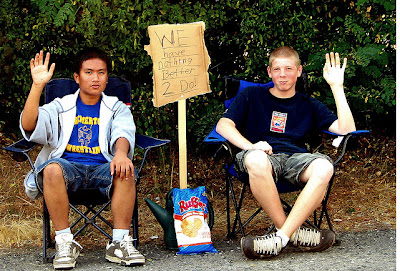I'm just heading back from the American Association for State and Local History conference in Salt Lake City where I facilitated a session called Banish the Boring, with the hope of getting my museum and history colleagues to think more deeply about the ways they do presentations (particularly at conferences) and be more experimental in our approach. We know our museum audiences don't learn most effectively when faced with a dark room and dense powerpoint slides. But it still mystifies me that we persist in making many (far too many!) conference sessions work this way. So I thought I would start this 8:30 AM session with voting as you walked in the door--you got asked to vote for three top questions and then small groups worked to find new ideas for those top three that can help solve these common issues. Here'sthe real-time solutions participants suggested. Special thanks for Alice Parman for not only notetaking but also typing up and sending me the notes--a really luxury as a session follow-up! I think these provide great guides for rethinking sessions--but the larger question is how we can rethink the overall conference experience to enhance learning and connections. But that's the subject of another post! If you have suggestions on the specifics or on the overall conference experience, please share in the comments.
Am I afraid
of using humor in a professional presentation?
• Establish your authenticity—then be as funny/real as you
want. Authenticity relates to your own comfort level.
• Use video clips, etc.
• Use drama
• If a joke falls flat, acknowledge it. Just keep moving
forward.
• Arrange with a friend to help you out in case it falls
flat.
• Humor should be relevant to your topic.
How do I
tactfully cut off someone who is taking over the session?
• Engage a person who’s not talking: “We haven’t heard from
you yet.”
• Parking lot technique: after the session we’ll go into
more detail.
• Subtly cue a fellow panelist that it’s time to wrap up
• Universalize—summarize
• Let’s meet afterward
• If you’re passing a mike around, hold onto it yourself
• Ringer(s) in audience to intervene
• Come with prepared questions to move things in a different
direction
• Move around. Get closer to the person. Physical
intimidation. Do what a Rotary president does when a speaker goes on too long.
How can I start a session
with a bang?
• Use question or metaphor
• Pictures of things that look similar but are different
• Tell a personally engaging story
• Talk about something you did that fell on its face
• Ask audience members to reflect, write
• Give them a question, they write the answer; same
question/written answer at end of presentation, have they changed perspective?
• Setting the stage
• Move people around
• Begin with anecdote, technology, video
• This is an open meeting, you’re in charge of the agenda
• Play music really loud (Nina Simon)
• Hire a high school marching band
How do I make my session description
sound interesting, but accurate?
• Know your audience
• Be as accurate and specific as possible
• Fun things, active verbs
• Key buzzwords, but not too many
• Catchy title that refers to topic—alliteration, humor
• Write creatively to awaken interest by connecting to
readers’ needs
• Session descriptions as little narratives/stories. See Ira
Glass, What makes a good story? on
YouTube
How can I develop small
group activities that get to the point of the session?
• Copy what Linda did in this session
• Ask questions, group provides the answers
• Group builds something, solves a problem
• Engage people in something related to the topic
• Goal of activity must be established first
• Find out what people want to know
• Written instructions
• Talk to people like it’s a group of friends
• Speaker bingo: head shots of presenters, if you hear
or meet 4 you get bingo, then you are entered in a drawing. Two-line bios of
presenters on other side of bingo card.
(Comment: don’t read bios to the audience—especially if those bios are
already in the program!)


2 comments:
Playing music before a session is my favorite way to warm people up... and the only time I get to pretend I'm cool.
More seriously, the most important thing I've learned after leading lots of sessions is:
--make sure you are spending at least 50% of the time on dialogue with audience (or workshops, etc). 5-7 min per presenter is PLENTY.
--be honest, be open, tell true stories, use numbers. I hate it when a presentation clearly has some "secret sauce" behind it, or the interesting bit can't be said, etc. Give us blood, preferably your own.
The 50% is a great rule of thumb--thanks for numerically making clear something I did by sort of instinct...and yes, true honest stories (Atlanta History Center did a great job at this at an AASLH session). And numbers--I'm not necessarily a numbers person (hence no clue about the 50%) but you're right, I am finding them increasingly important--not just budget numbers, but audiences, change over time, demographics...Thanks for sharing your thoughts--and we'll look forward to more music in Baltimore!
Post a Comment